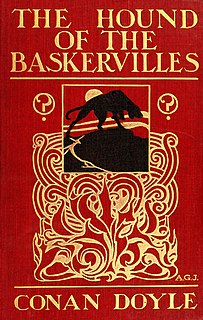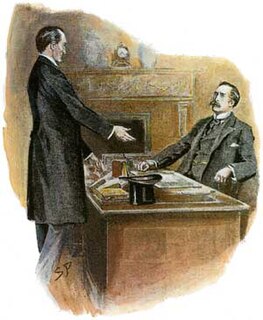Related Research Articles

Sherlock Holmes is a fictional detective created by British author Sir Arthur Conan Doyle. Referring to himself as a "consulting detective" in the stories, Holmes is known for his proficiency with observation, deduction, forensic science and logical reasoning that borders on the fantastic, which he employs when investigating cases for a wide variety of clients, including Scotland Yard.

The Hound of the Baskervilles is the third of the four crime novels written by Sir Arthur Conan Doyle featuring the detective Sherlock Holmes. Originally serialised in The Strand Magazine from August 1901 to April 1902, it is set largely on Dartmoor in Devon in England's West Country and tells the story of an attempted murder inspired by the legend of a fearsome, diabolical hound of supernatural origin. Holmes and Watson investigate the case. This was the first appearance of Holmes since his apparent death in "The Final Problem", and the success of The Hound of the Baskervilles led to the character's eventual revival.

Adrian Malcolm Conan Doyle was the youngest son of Sir Arthur Conan Doyle and his second wife Jean, Lady Doyle or Lady Conan Doyle. He had two siblings, sister Jean Conan Doyle and brother Denis, as well as two half-siblings, sister Mary and brother Kingsley.

The Case-Book of Sherlock Holmes is the final set of twelve Sherlock Holmes short stories by Arthur Conan Doyle first published in the Strand Magazine between October 1921 and April 1927.

The Exploits of Sherlock Holmes is a short story collection of twelve Sherlock Holmes pastiches, first published in 1954. It was written by Adrian Conan Doyle, who was the son of Sir Arthur Conan Doyle, and by John Dickson Carr, who was the authorised biographer of the elder Conan Doyle. The first six stories were written in collaboration by the two writers, while the last six stories were written solely by Adrian Conan Doyle.

The Adventure of the Dancing Men is a Sherlock Holmes story written by Sir Arthur Conan Doyle as one of 13 stories in the cycle published as The Return of Sherlock Holmes in 1905. It was first published in The Strand Magazine in the United Kingdom in December 1903, and in Collier's in the United States on 5 December 1903.
The stories of Sherlock Holmes by Sir Arthur Conan Doyle have been very popular as adaptations for the stage, and later film, and still later television. The four volumes of the Universal Sherlock Holmes (1995) compiled by Ronald B. De Waal lists over 25,000 Holmes-related productions and products. They include the original writings, "together with the translations of these tales into sixty-three languages, plus Braille and shorthand, the writings about the Writings or higher criticism, writings about Sherlockians and their societies, memorials and memorabilia, games, puzzles and quizzes, phonograph records, audio and video tapes, compact discs, laser discs, ballets, films, musicals, operettas, oratorios, plays, radio and television programs, parodies and pastiches, children's books, cartoons, comics, and a multitude of other items — from advertisements to wine — that have accumulated throughout the world on the two most famous characters in literature."

Traditionally, the canon of Sherlock Holmes consists of the 56 short stories and four novels written by Sir Arthur Conan Doyle. In this context, the term "canon" is an attempt to distinguish between Doyle's original works and subsequent works by other authors using the same characters.

A series of fourteen films based on Sir Arthur Conan Doyle's Sherlock Holmes stories was released between 1939 and 1946; the British actors Basil Rathbone and Nigel Bruce played Holmes and Dr. John Watson, respectively. The first two films in the series were produced by 20th Century Fox and released in 1939. The studio stopped making the films after these, but Universal Studios acquired the rights from the Doyle estate and produced a further twelve films.

"The Story of the Lost Special", sometimes abbreviated to "The Lost Special", is a mystery short story by Arthur Conan Doyle first published in The Strand Magazine in August 1898. A minor character in the story is possibly implied to be Doyle's character Sherlock Holmes, though his name is not used and this character does not provide the mystery's solution. The story's narrative mode is third person, subjective, though the narrator is not identified.

Bertram Fletcher Robinson was an English sportsman, journalist, author and Liberal Unionist Party campaigner. Between 1893 and 1907, he wrote nearly three hundred items, including a series of short stories that feature a detective called "Addington Peace". However, Robinson is perhaps best remembered for his literary collaborations with his friends Arthur Conan Doyle and P. G. Wodehouse.

Ainslee's Magazine was an American literary periodical published from 1897 to December 1926. It was originally published as a humor magazine called The Yellow Kid, based on the popular comic strip character. It was renamed Ainslee's the following year.

Cromer Hall is a country house located one mile south of Cromer on Holt Road, in the English county of Norfolk. The present house was built in 1829 by architect William Donthorne. The hall is a grade II* listed building.

The Sign of Four is a 1983 British made-for-television mystery film directed by Desmond Davis and starring Ian Richardson and David Healy. The film is based on Sir Arthur Conan Doyle's 1890 novel of the same name, the second novel to feature Sherlock Holmes and Doctor Watson.

The Hound of the Baskervilles is a 1983 British made-for-television mystery thriller film directed by Douglas Hickox, starring Ian Richardson as Sherlock Holmes and Donald Churchill as Dr. John H. Watson. It is based on Arthur Conan Doyle's 1902 novel The Hound of the Baskervilles.

The Hound of the Baskervilles is a 1932 British mystery film directed by Gareth Gundrey and starring John Stuart, Robert Rendel and Frederick Lloyd. It is based on the 1902 novel The Hound of the Baskervilles by Arthur Conan Doyle, in which Sherlock Holmes is called in to investigate a suspicious death on Dartmoor. It was made by Gainsborough Pictures. The screenplay was written by Edgar Wallace.

The Hound of the Baskervilles is a 1921 British silent mystery film directed by Maurice Elvey and starring Eille Norwood, Catina Campbell and Rex McDougall. It is based on the 1902 Sherlock Holmes novel The Hound of the Baskervilles by Arthur Conan Doyle. It was made by Stoll Pictures, Britain's largest film company at the time. It was the first British film adaptation of the famous novel.

The Hound of the Baskervilles is a 1972 American made-for-television mystery film directed by Barry Crane and starring Stewart Granger as Sherlock Holmes and Bernard Fox as Doctor Watson. The movie is based on Arthur Conan Doyle's 1902 Sherlock Holmes novel The Hound of the Baskervilles.
"The Field Bazaar" is a short story by Arthur Conan Doyle, first published on November 20, 1896 in a special "Bazaar Number" of The Student, a publication of the students' representative council at Edinburgh University. It is a Sherlock Holmes story, published under Conan Doyle's byline and featuring both Holmes and his partner, Dr. John Watson. It is, however, treated by most experts as a parody or pastiche not suitable for inclusion in the traditional 60-story canon of Sherlock Holmes, though there are dissenters.
References
- ↑ Russell Miller, The Adventures of Arthur Conan Doyle (St. Martin's Press 2008), chapter 14; W.W. Robson, Introduction, in Arthur Conan Doyle, The Hound of the Baskervilles (edited by Owen Dudley Edwards) (Oxford University Press 1993), page xvi; Ronald Pearsall, Conan Doyle: A Biographical Solution (St. Martin's Press 1977), page 92.
- 1 2 Jennifer L. Behrens, On the Scent: A History of "The King of the Foxes" Autograph Manuscript, in Regulation and Imagination: Legal and Literary Perspectives on Fox-hunting (edited by Ross E. Davies) (Green Bag Press 2021), page 118.
- ↑ The Chiddingfold Hunt: Farmers, Keepers and Puppy-Walkers Entertained, Surrey Times (August 12, 1905), page 5.
- ↑ Ashley D. Polasek, Arthur Conan Doyle and the Literature of Fox-hunting, in Regulation and Imagination: Legal and Literary Perspectives on Fox-hunting (edited by Ross E. Davies) (Green Bag Press 2021), pages 17-29.
- ↑ Sir Arthur Conan Doyle, Conan Doyle On The War, The Sunday (Washington, DC) Star (July 27, 1930), page 1.